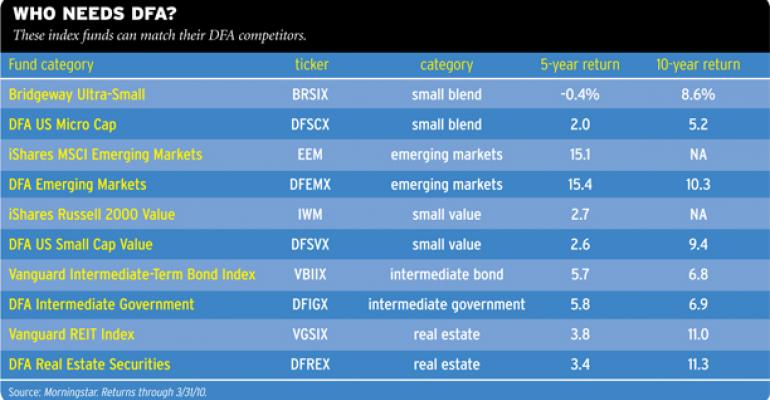There is much to like about Dimensional Fund Advisors' passive funds. After all, the fund family was founded by Eugene Fama and Kenneth French, two pioneers in portfolio theory. DFA funds are customizable for clients of fee-only financial advisors and are not sold directly to retail investors. But plenty of advisors are reluctant to use DFA because they have to go through a training program to do so. And in some cases competitors offer passive funds that are superior to their DFA counterparts.
Consider DFA US Micro Cap (DFSCX), which returned 5.2 percent annually during the decade ending in March. While the performance was respectable, the fund lagged behind Bridgeway Ultra-Small Company Market (BRSIX), which returned 8.6 percent. The Bridgeway fund also recorded lower standard deviation and beta risk scores.
Bridgeway succeeded by beating DFA at its own game. The Bridgeway fund owns stocks that are smaller and cheaper than the holdings in DFA US Micro Cap. The Bridgeway portfolio has an average market capitalization of $165 million and a price-earnings multiple of 13.2. In comparison, DFA's market cap is $393 million and the p/e is 13.6.
In the past, DFA could boast about offering funds that were the only passive choices in certain categories. But the rise of ETFs has introduced new competitors. DFA US Small Cap Value I (DFSVX) was the only game in town when it began in 1993. Now many investors may prefer iShares Russell 2000 Value (IWN). During the past five years, the iShares fund has returned 2.7 percent annually, nosing a bit ahead of the DFA fund, which returned 2.6 percent. The ETF charges an annual expense ratio of 0.33 percent, compared to 0.54 percent for the DFA fund.
Among the brightest stars of the past decade has been DFA Intermediate Government Fixed-Income (DFIGX), which returned 6.9 percent, compared to 6.8 percent for Vanguard Intermediate-Term Bond Index (VBIIX). But going forward, many investors should prefer the Vanguard fund. That's because the DFA portfolio only holds government bonds with AAA ratings. If interest rates rise, as nearly everyone expects they will, Treasuries will be clobbered. Vanguard, which holds a mix of governments and corporate issues, will take the lead. That has already started to happen. With interest rates rising during the past year, DFA has returned 2.4 percent, compared to 10.0 percent for Vanguard.
In a more even matchup, Vanguard REIT Index (VGSIX) nearly duplicated the results of DFA Real Estate Securities (DFREX). Not only are the 10-year returns similar, but both funds have nearly identical standard deviations. That should not be surprising because the two portfolios have the same top 10 holdings. Frugal investors might give the nod to Vanguard because of its slightly lower fees.






